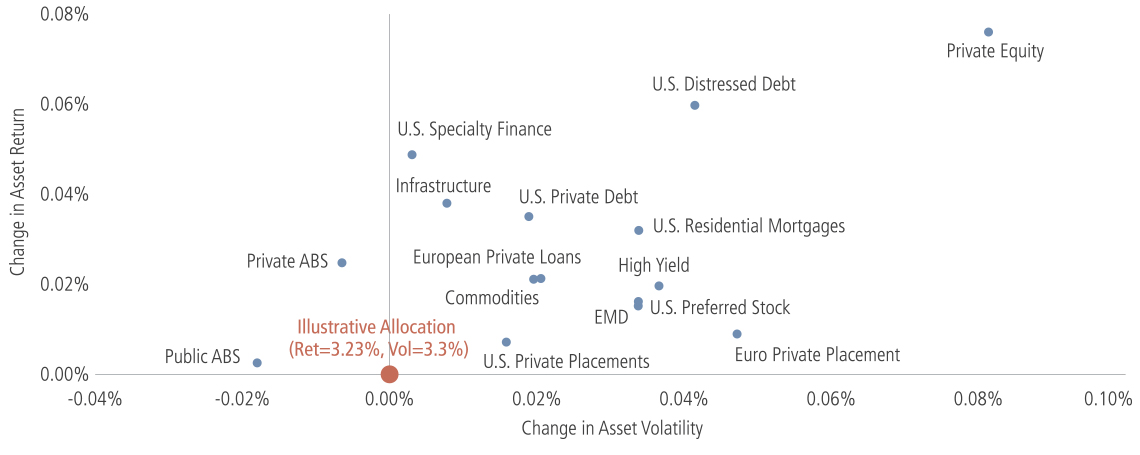Additional Disclosures
Index Definitions
The Bloomberg Euro Treasury Index consists of fixed-rate, investment-grade public obligations of the sovereign countries participating in the European Monetary Union. This index currently contains euro-denominated issues from 18 countries. The index was created in 1998, with history backfilled to June 1, 1998.
The Bloomberg Euro Corporate Bond Index is a broad-based benchmark that measures the investment grade, euro-denominated, fixed-rate corporate bond market. Inclusion is based on currency denomination of a bond and not country of risk of the issuer. The Index was launched on 1 June 1998.
The Bloomberg Euro High Yield Index measures the market of non-investment grade, fixed-rate corporate bonds denominated in Euro. Inclusion is based on the currency of issue and not the domicile of the issuer. The index excludes emerging market debt. It was created in 1999 and is part of the Global High Yield Index.
The Markit iBoxx EUR Liquid Non-Financials Index is a subset of the Markit iBoxx EUR Non-Financials bonds universe and contains up to 20 investment grade rated non-financial securities with maturity 5-7yrs and a BBB rating. All bonds need to have an average rating of investment grade from Fitch Ratings, Moody’s Investor Service and Standard & Poor’s Rating Services.
The S&P Eurozone Sovereign Bond Index seeks to measure the performance of fixed-rate locally denominated sovereign debt publicly issued by Eurozone country governments for their domestic markets.
The Bloomberg U.S. Government Index includes Treasuries (public obligations of the U.S. Treasury that have remaining maturities of more than one year) and U.S. agency debentures (publicly issued debt of U.S. Government agencies, quasi-federal corporations, and corporate or foreign debt guaranteed by the U.S. Government).
The Bloomberg Municipal Bond Index covers USD-denominated, long-term, tax-exempt state and local general obligation bonds, revenue bonds, insured bonds, and prerefunded bonds.
The Bloomberg U.S. Corporate Index measures the investment grade, fixed-rate, taxable corporate bond market. It includes USD-denominated securities publicly issued by U.S. and non-U.S. industrial, utility and financial issuers that meet specified maturity, liquidity and quality requirements. The Index was launched on January 1, 1973.
The Bloomberg U.S. Corporate High Yield Bond Index covers the USD-denominated, non-investment grade, fixed-rate, taxable corporate bond market. Securities are classified as high-yield if the middle rating of Moody’s Fitch, and S&P is Ba1/BB+/BB+ or below. The index excludes Emerging Markets debt. The Index was created in 1986, with index history backfilled to January 1, 1983.
The Morningstar LSTA U.S. Leveraged Loan Index is a market-value weighted index designed to measure the performance of the market in U.S. syndicated, term leveraged loans that are held within top-tier institutional investor loan portfolios tracked by PitchBook and LCD.
The JPMorgan Emerging Markets Bond Global Diversified Index (EMBI GD) includes U.S. dollar-denominated Brady bonds, Eurobonds, and traded loans issued by sovereign and quasi-sovereign entities.
The JPMorgan Corporate Emerging Markets Bond Diversified Index (CEMBI) is a market-capitalization weighted index of corporate bonds issued by entities in emerging countries.
The S&P 500 Index consists of 500 U.S. stocks chosen for market size, liquidity and industry group representation. It is a market value-weighted index (stock price times number of shares outstanding), with each stock’s weight in the Index proportionate to its market value.
The MSCI All Country World Index ex USA is a market value-weighted index of more than 2,700 stocks from 22 developed and 24 emerging countries, excluding the U.S.
The MSCI EAFE Index aims to capture the performance of large and mid cap quality growth stocks across 21 developed market countries excluding the U.S. and Canada.
The MSCI Emerging Markets Index is a market-value weighted index designed to represent the performance of large- and mid-cap securities in 26 emerging markets.
The MSCI Europe Index captures large and mid cap representation across 15 Developed Markets countries in Europe. With 427 constituents, the index covers approximately 85% of the free float-adjusted market capitalization across the European Developed Markets equity universe.
The Burgiss Global Buyout Funds Index tracks the performance of closed-ended private equity buyout funds in the Burgiss Manager Universe, converted to U.S. dollars.
The Burgiss U.S. Private Debt Funds Index tracks the performance of U.S. closed-ended private debt funds in the Burgiss Manager Universe.
The Burgiss Infrastructure Index tracks Investments in long-life assets, properties, or other structures that provide some type of essential product or service; these often generate investment returns through income. Includes midstream and downstream oil and gas, power generation, transmission and distribution, telecommunication, and logistic assets.
The Bloomberg U.S. Corporate BB High Yield (1-3 years) Index measures the USD-denominated, high yield, fixed-rate corporate bond market with maturities of 1-3 years and a BB rating.
The Bloomberg ABS Index tracks the investment grade ABS components of the Bloomberg U.S. Aggregate index. Securities must be rated investment-grade by at least two of the following ratings agencies: Moody’s, S&P, Fitch. If only two of the three agencies rate the security, the lower rating is used to determine index eligibility. If only one of the three agencies rates a security, the rating must be investment-grade. Securities must be ERISA eligible under the underwriter’s exemption. 144A securities are not included. The ABS index includes pass-through, bullet, and controlled amortization structures. The ABS index includes only the senior class of each ABS issue and the ERISA-eligible B and C tranche.
The Credit Suisse Distressed Loan Index is a subset of the Credit Suisse Leveraged Loan Index, and includes loans priced at 90% of par or lower, as at the Index Rebalance Day.
Asset Class Assumptions & Estimates
Capital market assumptions used herein reflect Neuberger Berman’s forward-looking estimates of the benchmark return or volatility associated with an asset class. Estimated returns and volatilities are hypothetical return and risk estimates generated by Neuberger Berman’s Institutional Solutions Group. Estimated returns and volatilities do not reflect the alpha of any investment manager or investment strategy/vehicle within an asset class. Information is not intended to be representative of any investment product or strategy and does not reflect the fees and expenses associated with managing a portfolio or any other related charges, such as commissions and surrender charges. Estimated returns and volatilities are hypothetical and generated by Neuberger Berman based on various assumptions and inputs, including current market conditions, historical market conditions and subjective views and estimates. Capital market assumptions shown reflect Neuberger Berman’s long-term (20+ years into the future) estimates or intermediate-term (5-7 years into the future) estimates which are reviewed at least annually. Results will differ depending on whether they are based on Neuberger Berman’s long-term (20+ years into the future) or intermediate-term (5-7 years into the future) capital market assumptions. Neuberger Berman’s capital market assumptions are derived using a building block approach that reflects historical, current, and projected market environments, forward-looking trends of return drivers, and the historical relationships asset classes have to one another. These hypothetical returns are used for discussion purposes only and are not intended to represent, and should not be construed to represent, predictions of future rates of return. Actual returns may vary significantly. Neuberger Berman makes no representations regarding the reasonableness or completeness of any such assumptions and inputs. Assumptions, inputs, and estimates are periodically revised and subject to change without notice. Estimated returns and volatilities should not be used, or relied upon, to make investment decisions.
Rate of Return Estimate: Rate of return or geometric return is a measure of average returns of an investment over a period of time. Geometric rate of returns are typically referred to as annualized compound rate of returns and are always less than or equal to the arithmetic mean return of the same time series. Geometric rate of returns are used for straight-line calculations within the analysis, for example, the cash flow calculations. In straight-line calculations, each year is represented as a gain, so the compound (geometric mean) rate of return is used to adjust for the amount needed to make up for a loss in a given year. For example, if you lose 5% in one year, and gain 5% the year after, you still have less than you started with at the beginning of year one.
Arithmetic Mean Estimate: Arithmetic mean or average return is calculated by dividing the sum of a series of numbers by the number of overall items. This is more typically thought of as an “average” of the data set. Arithmetic mean or average return ignores the impact of compounding in the context of analyzing investment returns and is the simple average of returns observed over a period of time. Arithmetic mean returns are used in this material and, if applicable, the Efficient Frontier, because, through randomization, losses and gains are being accounted for each year.
Standard Deviation: A statistical measure of the volatility based on the distribution of a set of data from its mean (average value). For example, a portfolio with an average return of 10% and a standard deviation of 15% would return a result between -5% and +25% the majority of the time (68% probability or 1 standard deviation), almost all of the time the return would be between -20% and +40% (95% probability or 2 standard deviations). If there were 0 standard deviation then the result would always be 10%. Generally, more aggressive portfolios have a higher standard deviation and more conservative portfolios have a lower standard deviation.
This material is provided for informational purposes only and nothing herein constitutes investment, legal, accounting or tax advice. This material is general in nature and is not directed to any category of investors and should not be regarded as individualized, a recommendation, investment advice or a suggestion to engage in or refrain from any investment-related course of action. Investment decisions and the appropriateness of this material should be made based on an investor’s individual objectives and circumstances and in consultation with his or her advisors. Information is obtained from sources deemed reliable, but there is no representation or warranty as to its accuracy, completeness or reliability. All information is current as of the date of this material and is subject to change without notice. The firm, its employees and advisory accounts may hold positions of any companies discussed. Any views or opinions expressed may not reflect those of the firm as a whole. Neuberger Berman products and services may not be available in all jurisdictions or to all client types. References to third-party sites are for informational purposes only and do not imply any endorsement, approval, investigation, verification or monitoring by Neuberger Berman of any content or information contained within or accessible from such sites.
Investing entails risks, including possible loss of principal. Investments in hedge funds and private equity are speculative and involve a higher degree of risk than more traditional investments. Investments in hedge funds and private equity are intended for sophisticated investors only. Indexes are unmanaged and are not available for direct investment. Past performance is no guarantee of future results. This material may include estimates, outlooks, projections and other “forward-looking statements.” Due to a variety of factors, actual events or market behavior may differ significantly from any views expressed. Investing entails risks, including possible loss of principal. Investments in hedge funds and private equity are speculative and involve a higher degree of risk than more traditional investments. Investments in hedge funds and private equity are intended for sophisticated investors only. Indexes are unmanaged and are not available for direct investment. Past performance is no guarantee of future results.
The views of the research analyst and the firm and its employees on medical topics should not be relied upon as medical advice and are not intended to serve as a substitute for consulting with a qualified medical professional. There is no representation or warranty as to its accuracy, completeness or reliability. All information is current as of the date of the material and is subject to change without notice. The firm, its employees and advisory accounts may hold positions of the manufacturers of the products discussed.
No part of this document may be reproduced in any manner without prior written permission of Neuberger Berman Europe Limited.
This material is being issued on a limited basis through various global subsidiaries and affiliates of Neuberger Berman Group LLC. Please visit www.nb.com/disclosure-global-communications for the specific entities and jurisdictional limitations and restrictions.
The “Neuberger Berman” name and logo are registered service marks of Neuberger Berman Group LLC.













